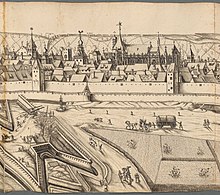Regensburg market tower
Regensburg's market tower , which has not been preserved , was part of the old town hall and, until its destruction in 1706, it was a landmark of the city that was visible from afar and the center of bourgeois, urban life.
Construction, location and use
The seven-storey market tower, equipped with a market bell and clock and erected in the defensive-looking raised masonry, was intended to demonstrate the self-confidence of the Regensburg citizens. The market tower is mentioned for the first time in 1347 in the description of a measure to embellish its helmet roof in 1347 with " a beautiful large button ". As old depictions of Regensburg and a merian engraving of the town hall building from 1644 show, the market tower with dome and weathercock was as high as the helmet-armored cathedral towers and slightly higher than the 55 m high town hall tower, only a little to the west, with battlements. The market tower stood at the eastern corner of the old town hall building on today's Zieroldsplatz, which at that time was called " at (behind) the market tower " until the 18th century . The market tower was one of the most beautiful buildings in the city, a symbol of the city and the pride of the citizens. With its location at the town hall between Coal Market and Zieroldsplatz and with its large passage to the fish market on the banks of the Danube, the tower was the focus of civil life in the city. Next to the tower was the location of the large pillory for three maleficants . From the tower room, the tower keepers watched over the security of the city day and night and during city festivities the trumpet concert of the tower winds sounded from its high gallery. When the market and town hall towers burned down in 1360, both were immediately rebuilt with the help of a special tax from the citizens. The city council still spared no expense in maintaining the market tower and placed a large rooster on the dome of its roof as a symbol of the vigilance of the authorities.
Furnishing
In 1510 the tower was equipped with an ornate clock and a large bell, which announced the passage of the hours with alarming loudness during the day. The end of the night hours was announced by means of a small, brightly sounding bell. In 1551 a well for the public water supply was set up at the market tower, which was supplied with water from the water pipe of Dech Betten . When in 1573 the decision was made to make the inconsistent fronts of the various town hall buildings appear more uniform by painting the façade, the façades of the market tower were to be included in the planned design program. The alliance of the imperial city of Regensburg with the Habsburg imperial family should be particularly emphasized on the south facade as the prominent front side. For this, the motifs z. For example, the Habsburg double-headed eagle was chosen, represented together with the Regensburg city arms and the depictions of " Jupiter's fall of the giants " as a symbol of the victory of order and law over rebellion and Turkish attacks were intended to support the Habsburg monarchy .
Destruction and Consequences
The negligence of the tower guard Johann Balthasar Bucher led to the market tower on fire on July 26th, 1706. The attempts to extinguish the fire caused great water damage in the town hall, but could not stop the fire in the tower. The heat became so intense that the walls of the tower burst and the ruins had to be demolished. The functions of the city tower were first transferred to the Golden Tower in Wahlenstrasse and then to the town hall tower. Plans to rebuild the tower in baroque form failed due to the city's lack of money.
Remarks
- ^ A b c Karl Bauer: Regensburg Art, Culture and Everyday History . 6th edition. MZ-Buchverlag in H. Gietl Verlag & Publication Service GmbH, Regenstauf 2014, ISBN 978-3-86646-300-4 , p. 261-267, 273-280 .
- ↑ Christine Riedl Valder: "Magnificently built, renewed, adorned from inside and outside" Façade and wall paintings from the second half of the 16th century in Regensburg. In: Working Group Regensburg Autumn Symposium (ed.): “Between Gothic and Baroque” traces of the Renaissance in Regensburg . tape 26 . Dr. Peter Morsbach Verlag, Regensburg 2012, ISBN 978-3-937527-55-0 , p. 191-197 .
Coordinates: 49 ° 1 ′ 13 ″ N , 12 ° 5 ′ 42.5 ″ E



